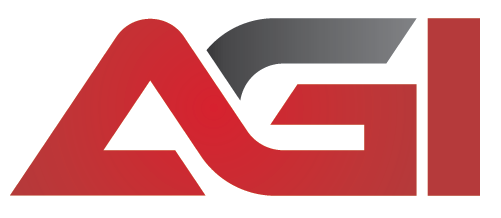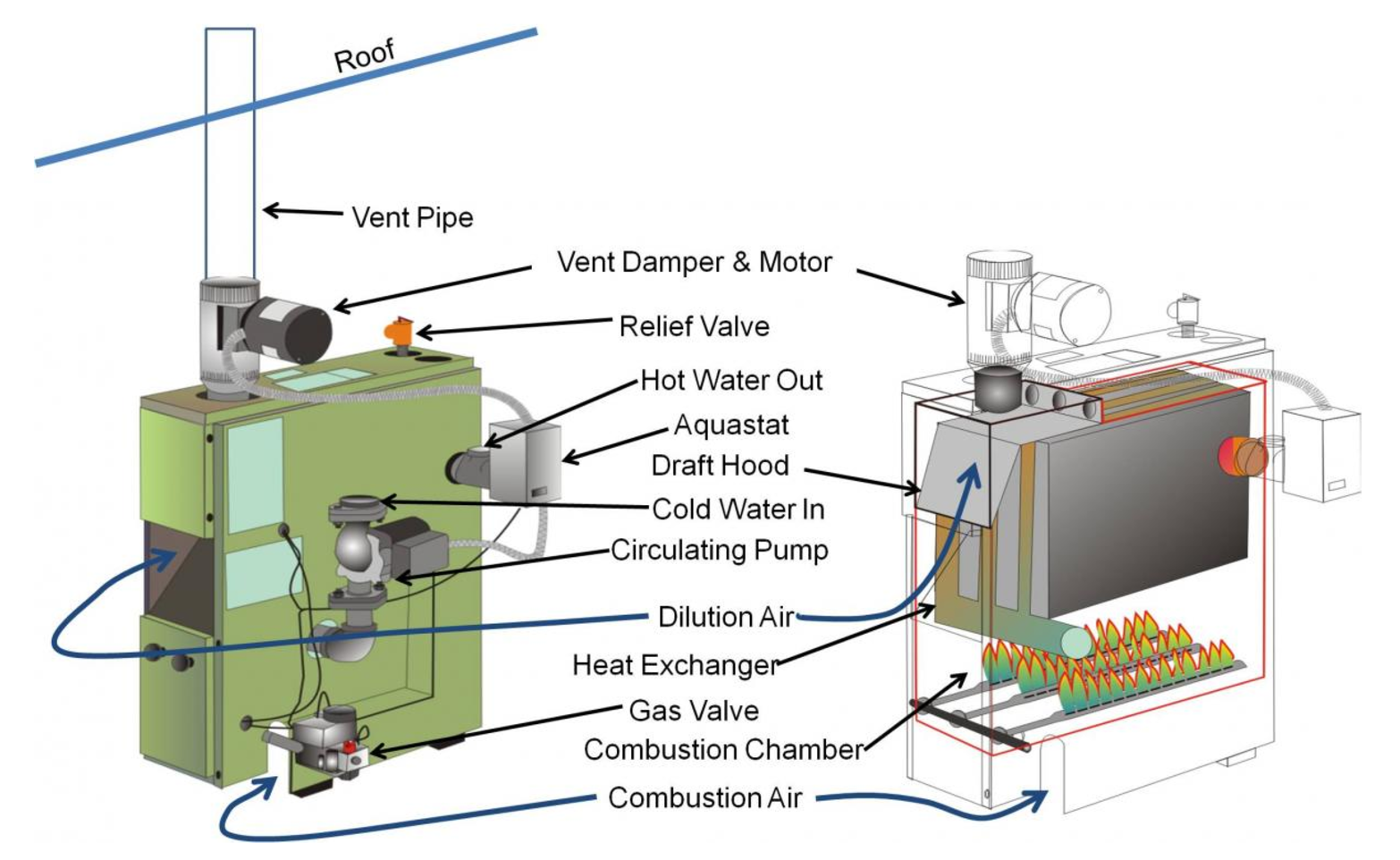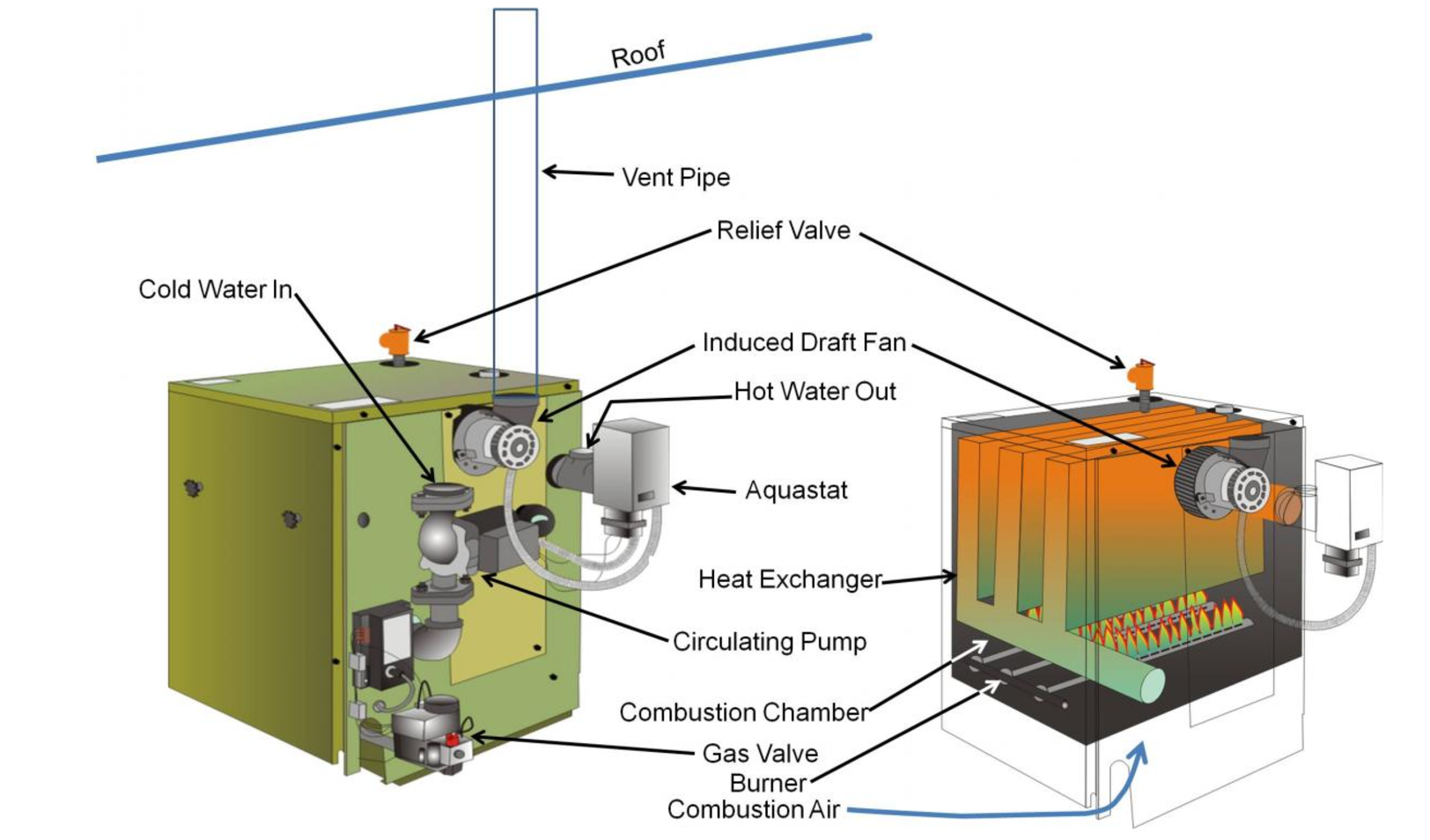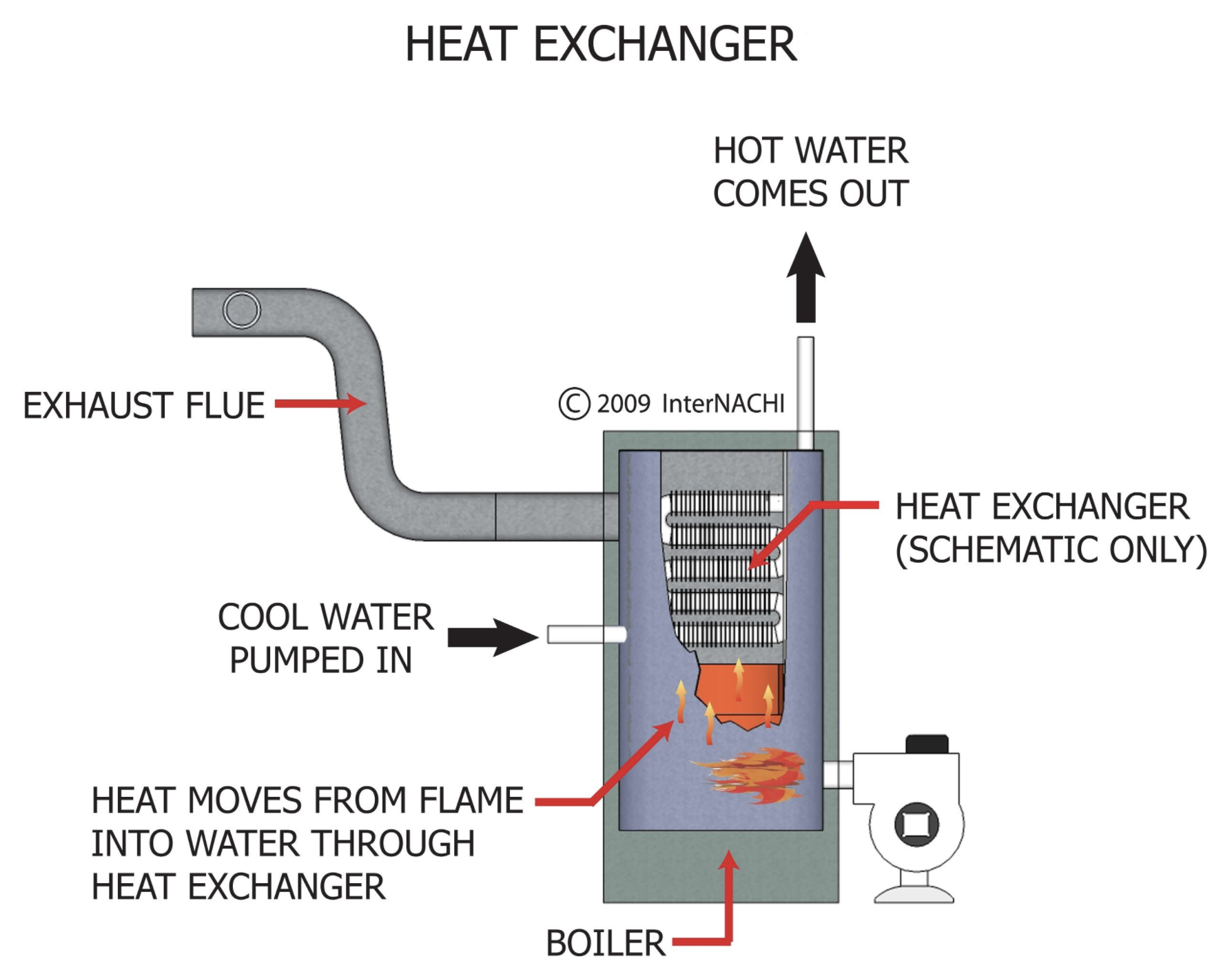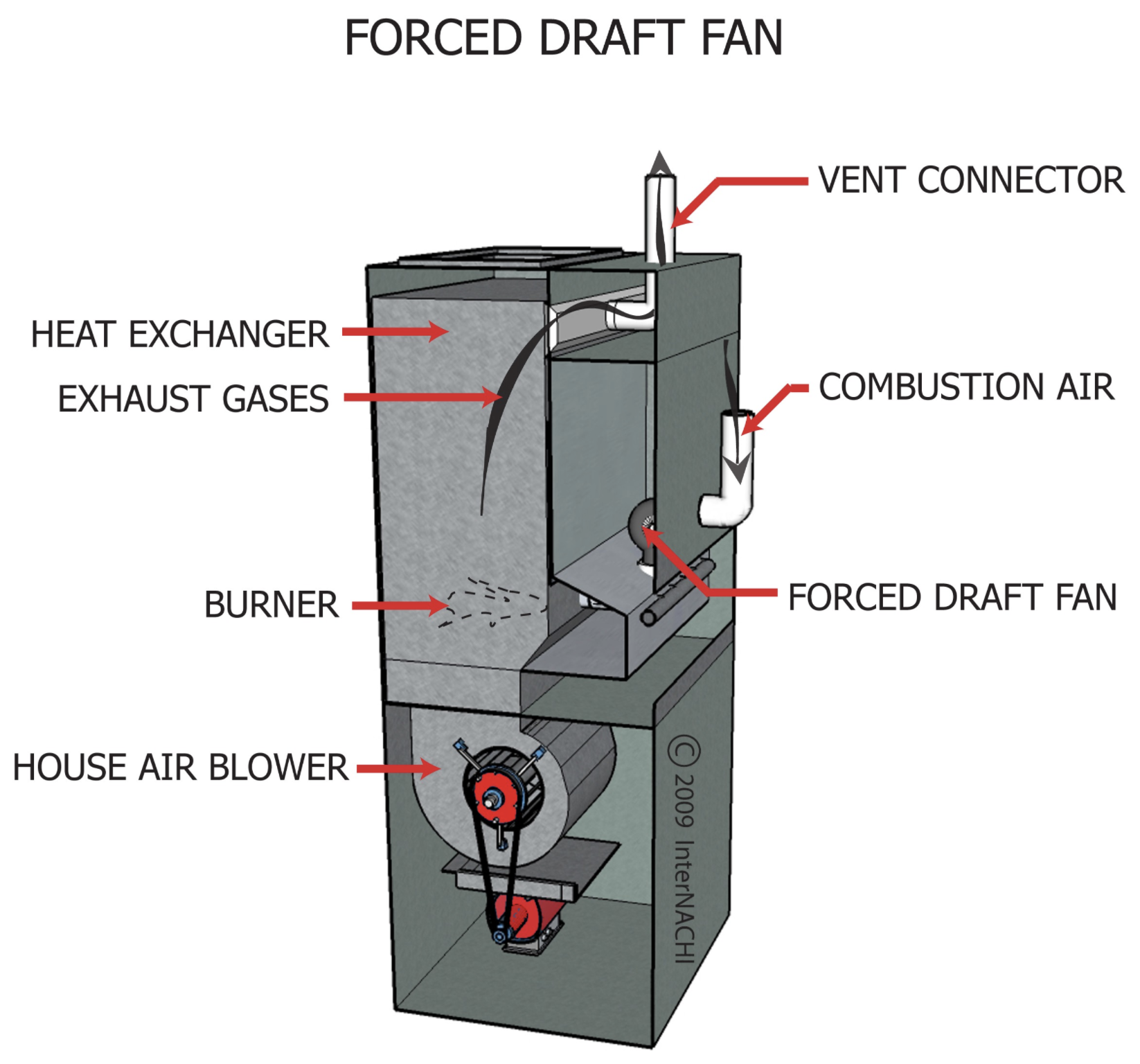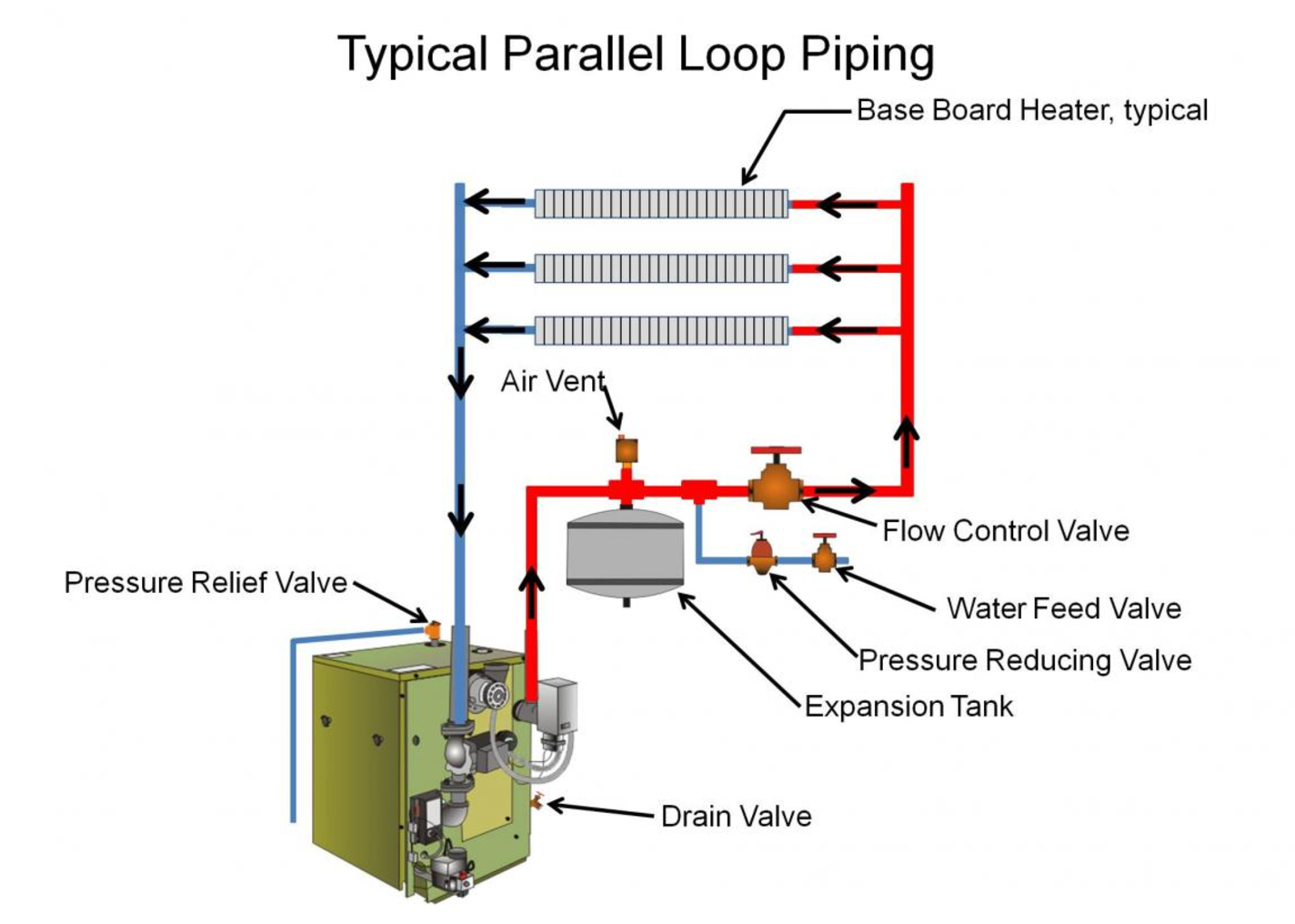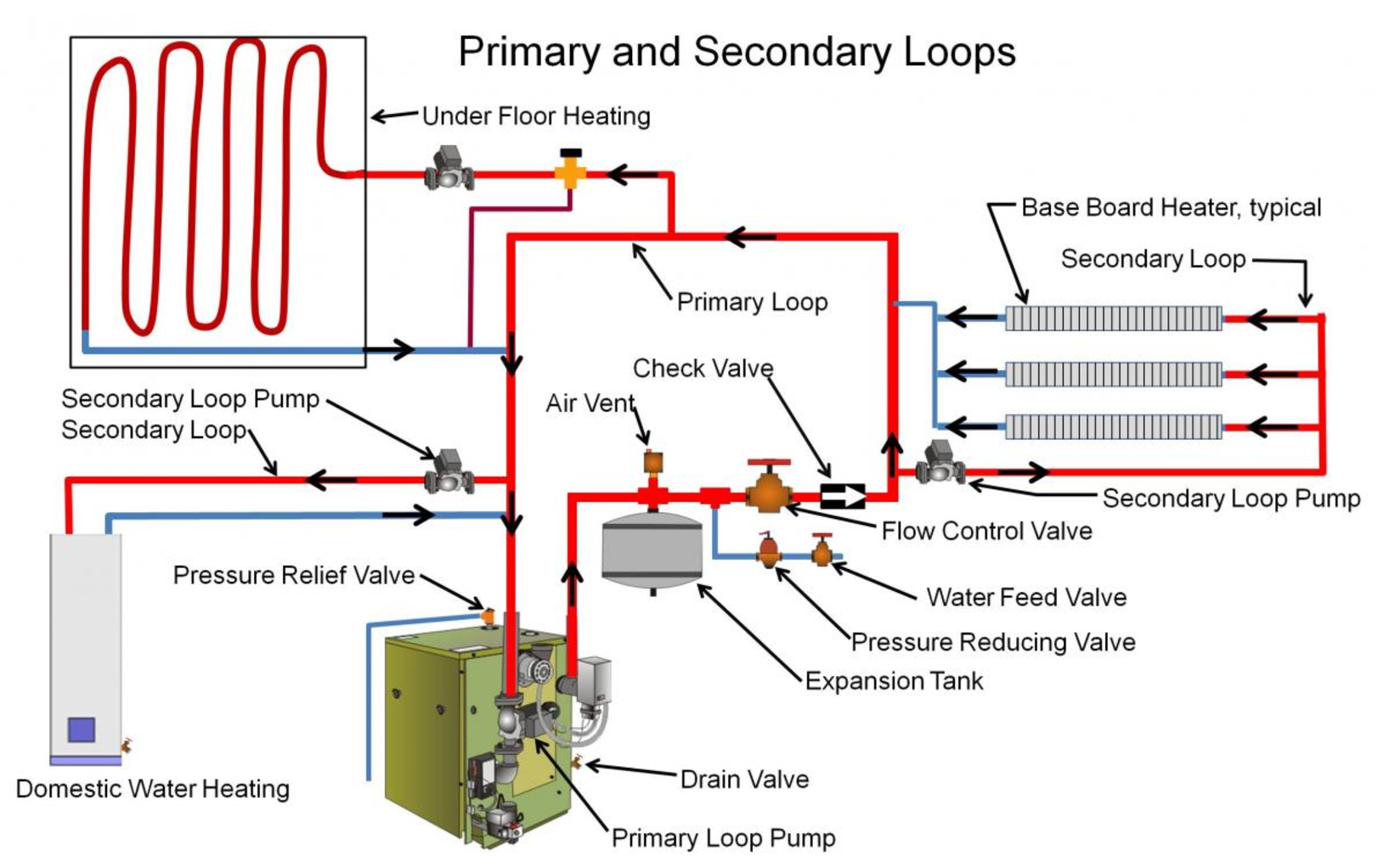- October 31, 2023
Inspecting Gas-Fired Boilers
Inspecting Gas Furnace home inspection lake charles
by Nick Gromicko and Katie McBride

Hot water or steam produced from a boiler can be used in different ways, including to heat a house. The hot water can be sent through plastic pipe loops in the floor for radiant floor heating, through metal radiators mounted along the wall, or to baseboard radiators mounted near the floor. Hot water can also be directed from a combustion tank water heater to a coil in an air handler equipped with a fan to blow air across the coil and through supply air ducts to the home. Most combustion boilers are fueled by natural gas. Fuel oil, propane, and wood are other fuel sources used in locations where natural gas is not readily available. The hot water for a boiler may also be heated or preheated by a solar thermal water heating system, a ground-source (geothermal) heat pump, or an air-source heat pump. The boiler may heat water in a tank, or it may be a tankless (instantaneous) wall-hung model. Some boilers provide heat for a potable hot water tank in addition to providing hot water to room heaters; this is referred to as indirect water heating. Some newer high-efficiency models combine space heating, water heating, and heat-recovery ventilation. These different methods of using hot water or steam to heat the house is something home inspectors can differentiate during a home inspection.

Combustion boilers, furnaces, and water heaters are classified by the International Mechanical Code (IMC) and the National Fuel Gas Code. Understanding the descriptions of these appliance types based on both codes is important with respect to safety and efficiency.
The International Mechanical Code classifies boilers based on vent type: direct, mechanical, or atmospheric. Per the 2009 and 2012 International Mechanical Code, Chapter 2 definitions:
- a direct-vent appliance is one that is constructed and installed so that all air for combustion is derived from the outdoor atmosphere, and all flue gases are discharged to the outside atmosphere;
- a mechanical draft system is a venting system designed to remove flue or vent gases by mechanical means consisting of an induced-draft portion under non-positive static pressure, or a forced-draft portion under positive static pressure; and a natural-draft system is a venting system designed to remove flue or vent gases under non-positive static vent pressure entirely by natural draft. Inspecting Gas Furnace home inspection lake charles
The 2015 National Fuel Gas Code (NFPA 54) has four categories for furnaces based on flue vent pressures, flue gas temperatures (related to condensing or non-condensing), and vent pipe materials, as shown in Table 1 below.
Table 1. The National Fuel Gas Code (NFPA 54) uses four categories for combustion furnaces and water heaters based on combustion type (sealed or unsealed), vent pipe pressure, and vent pipe temperature.
The lowest efficiency boilers are atmospherically vented, Category I boilers. A Category I boiler operates with the flue at negative pressure with respect to the combustion appliance zone or CAZ (i.e., the room where the boiler is located), and the stack temperature is above 140° F, which is hot enough to avoid condensation in the vent. The burner draws its combustion air from the CAZ. The combustion chamber is also open to the CAZ (i.e., the burner and flames are visible from the side of the boiler). Inspecting Gas Furnace home inspection lake charles
Older Category I boilers use an open draft hood that allows dilution air to enter the vent pipe and mix with the exhaust gases (see Figure 6 below). A draft diverter at the base of the flue protects the flame from downdrafts coming down the chimney or flue. These older boilers are not mechanically drafted but are called natural draft (or atmospheric draft) because they rely entirely on a high flue temperature relative to the outside temperature to draw exhaust gases up and out of the flue. Because so much of the heat goes up the chimney, natural-draft boilers have very low annual fuel utilization efficiency (AFUE) ratings — usually 70% or less.
A newer type of Category I boiler has replaced the draft hood with a small fan, referred to as an induced-draft fan, which pulls air through the combustion chamber, although the boiler still relies on the flue temperature to lift the combustion gases up the flue stack. The induced-draft fan helps to prevent backdrafting on startup and assists in getting the draft started. Once the vent pipe gets up to temperature 140° F or higher, a draft is established, and the pressure inside the vent pipe (on the positive side of the fan) becomes negative with respect to the CAZ. The induced-draft fan did away with the draft hood and dilution air, which wasted energy. Category I boilers that incorporate an induced-draft fan typically have cleaner or more complete combustion than their older counterparts and, therefore, expel less pollutants. The improved Category I boilers and furnaces also have an electronic ignition rather than a standing pilot light. Induced-draft Category I boilers can have an efficiency rating of 78% to 83%.
ENERGY STAR permits naturally drafted boilers in IECC Climates Zones 1 through 3, and the DOE Zero Energy-Ready Home Program permits them in Climates Zones 1 and 2, if they have an AFUE of at least 80%. However, draft hood-equipped boilers are very unlikely to exceed 70% efficiency, so essentially all 80% boilers and furnaces are considered induced-draft, power-vented or direct-vent. When naturally drafted boilers and furnaces are installed, a combustion safety test must be performed. Inspecting Gas Furnace home inspection lake charles
Figure 1. IECC Climate Zone Map
An induced-draft fan-equipped boiler or furnace is considered mechanically drafted. However, because it is still open combustion (i.e., it draws its combustion air from the CAZ), and because it relies on negative flue pressure to carry away combustion byproducts, it can, like the naturally vented boiler or furnace, have the potential to backdraft. Back-drafting (when combustion gases spill down into the CAZ rather than going out the flue) can occur if the CAZ becomes depressurized with respect to the flue. Several things could cause this to occur – running multiple exhaust fans and the dryer and the fireplace all at the same time, for example. This is something home inspectors can mention to homeowners during a home inspection. Inspecting Gas Furnace home inspection lake charles
Figures 1 and 2 below are Category I boilers. The boiler in Figure 6 uses the older technology of a draft hood, which pulls dilution air into the vent pipe. The newer boiler in Figure 6 replaces the draft hood with a small induced-draft fan that pulls the products of combustion through the combustion chamber and flue by pushing the byproducts of combustion out through the vent pipe.
Figure 2. In a Category I gas-fired natural-draft boiler, the natural draft of the heated flue pulls combustion air through the draft hood and into the combustion chamber (image courtesy of Calcs Plus).
Figure 3. A Category I induced-draft boiler uses an induced-draft fan to pull air through the combustion chamber and into the flue (image courtesy of Calcs Plus).
Category II applies to some commercial furnaces but not residential appliances.
A Category III combustion appliance has a vent pipe that is under positive pressure and the appliance is non-condensing, meaning its flue gases only go through one heat exchanger, and then exit through the vent at temperatures above 140° F. Category III appliances may include instantaneous gas water heaters and gas- or oil-fired boilers.
Category IV boilers are combustion appliances that have a vent pipe under positive pressure and flue gases under 140° F. The vent exhaust is low-temperature because Category IV appliances are equipped with two heat exchangers (or sometimes one extra-large heat exchanger). In the second heat exchanger, any remaining heat in the combustion air is extracted and water vapor (a byproduct of combustion) cools and condenses into liquid water. This liquid is drained to the sewer or to the outside through a condensate drain. The condensate is highly acidic (pH ≤ 3), so local codes may require that it be pretreated before disposing to the sewer. (See Condensing Boilers.) Inspecting Gas Furnace home inspection lake charles
Figure 4. Heat exchanger
Category III and Category IV boilers are both forced-draft (also referred to as power-vented) appliances, meaning that they are equipped with a combustion fan that is located before the burner to push air through the combustion chamber and out of the vent (see Figure 8). The fan is continually operating when the burner is firing so the vent stack pressure is always positive. The byproducts of complete combustion are CO2, H2O, and N.
Figure 5. Forced-draft fan
Category IV boilers, like Category III boilers, vent their combustion exhaust gases directly outside through a sealed pipe so they cannot be back-drafted. Category III and IV appliances should be installed as sealed-combustion/direct-vent appliances, which means their combustion chamber is sealed off from the CAZ, and they draw their combustion air from the outside via a second vent pipe or concentric pipes that bring combustion air directly to the combustion chamber from outside the home. However, although manufacturers do not recommend it, they are sometimes installed as non-direct-vent appliances, where the exhaust pipe is installed but the pipe for incoming air is not installed, so the boiler draws its combustion air from the CAZ.
Category IV boilers can be either gas-fired or oil-fired. (For more information on oil boilers, refer to the guide Oil-Fired Boilers. For more on Category IV boilers, see Condensing Boilers.)
Since 1992, the U.S. Department of Energy (DOE), under the National Appliance Energy Conservation Act, has required that small gas boilers have an AFUE of at least 80%. In 2015, the DOE issued a revised minimum efficiency standard of 82% for residential boilers. To be labeled as an ENERGY STAR appliance, a boiler must have an efficiency rating of 85% or higher. Inspecting Gas Furnace home inspection lake charles
The publication ENERGY STAR for Homes (Version 3, Rev 08) allows gas and oil furnaces and boilers to have an AFUE equal to or higher than 80% in Climate Zones 1, 2 and 3. In Climate Zones 4 through 8, ENERGY STAR requires that boilers have an efficiency rating equal to or higher than 85% and be ENERGY STAR-labeled.
The DOE Zero Energy-Ready Home Program allows an AFUE equal to or higher than 80% for boilers in Climate Zones 1 and 2 only. In Climate Zones 3 and 4 (except Marine Climate Zone 4), boilers must have an AFUE equal to or higher than 90%, and in Climate Zones 5 through 8 (plus Marine Climate Zone 4), boilers must have an AFUE of 94% or higher. Inspecting Gas Furnace home inspection lake charles
Boiler Controls
While older boilers are either on or off, newer boilers with multi-stage or modulating burners have adjustable output to better match heating loads. This reduces the number of on-off cycles (and cycling losses) and allows the boiler to operate for longer hours at lower firing rates, which improves efficiency. Non-modulating boilers have efficiencies of 85% to 90%. Boilers that operate in modulation mode rather than just on-off mode can improve the average boiler’s efficiency by up to 8%. Higher-efficiency models are also equipped with electronic controllers that can prolong equipment life, improve the boiler’s efficiency, and enhance comfort by adjusting the boiler’s water temperature, creating time-delay relays, performing automatic post-purge, preventing warm-weather boiler operation, controlling the position of mixing valves, and controlling pump speeds. These controls can increase the efficiency of non-condensing boilers by 10% or more, and reduce idle losses to 0.3%. Condensing gas boilers that are fully modulating and have advanced controls can achieve efficiencies ranging from 92% to 96%.
There are many settings that can be adjusted on a modern boiler to improve the efficiency, comfort, and performance of the equipment; these adjustments may provide better performance than the default factory settings.
An outdoor reset control, which matches the system output to the actual outdoor temperature conditions, will improve comfort for owners of both condensing and non-condensing equipment by preventing extreme spikes in indoor temperature when the outdoor temperatures are warmer than design conditions. If an outdoor reset is installed, home inspectors should recommend that homeowners do not use a night-time temperature setback strategy unless special controls have been installed that can override the reset control. Locate the outdoor sensor where it will not be exposed to a heat source, such as in direct sunlight or near a dryer exhaust vent.
When installing an outdoor reset control with a non-condensing boiler, choose settings so that the return temperature to the boiler is no lower than 140° F, in order to prevent condensing. However, when selecting the outdoor reset curve set points for a condensing boiler, choose settings so that the temperature of the water returning to the boiler is below 130° F. This ensures that the return temperatures are low enough to promote condensing, which will greatly increase the energy efficiency of the system (see Arena 2012 for more details). To ensure that the return temperature is below 130° F, the supply temperature will likely have to be reduced to below the factory setting. Make sure the heat emitters used (baseboards, radiators, etc.) are properly sized based on the average temperature in the distribution loop. If they’re undersized, they won’t release enough heat to the space and the water will return to the boiler at too high a temperature, preventing condensing. Radiant floor systems are typically set up to run at lower temperatures when installed, so they do not require additional adjustment to the boiler’s supply temperature. Inspecting Gas Furnace home inspection lake charles
If toe-kick heaters are being specified in homes that have condensing boilers with outdoor reset controls, make sure the toe-kick model specified is capable of operating at low temperatures. Many of the toe-kick heaters currently available will not operate below a supply temperature of 140° F. A properly designed and configured condensing hydronic system will have return temperatures below 130° F most of the year, leaving the occupants without heat in rooms with toe-kick heaters. Inspecting Gas Furnace home inspection lake charles
In highly insulated energy-efficient homes with correctly sized equipment, nighttime setback can cause comfort issues. A boiler that is correctly sized to meet the home’s design heating load will not have enough capacity to recover from the setback in a reasonable amount of time, especially if the system is designed with an outdoor reset control. Outdoor reset controls match the boiler’s supply temperature to the heating load based on the current outdoor conditions, severely hindering the system’s ability to raise the temperature in the space. If the boiler was set up with an outdoor reset control and no capability to override it, home inspectors can advise homeowners not to set their thermostat temperature back during nighttime hours. This is also recommended if the home is very energy-efficient and the boiler was sized to meet the design heating load.
If it is known that that the homeowner will employ a setback strategy, or if that capability is desired, controls can be installed to speed up temperature recovery, such as by:
- a boost control that automatically raises the boiler output target temperature if heating demand is not satisfied within a set number of minutes;
- an indoor sensor that works with the outdoor reset control to compensate for lags in response based on interior temperature; or
- a simple manual override switch. Oversizing the heat emitters and possibly the boiler may be necessary to meet the additional load induced during periods of setback recovery. Inspecting Gas Furnace home inspection lake charles
If the boiler is oversized compared to the design load, oversizing the heat emitters will help reduce short-cycling of the boiler. This may be the only option in situations where the smallest boilers are too large for the design load, or there are several zones, each of which has very small loads compared to the boiler’s capacity. In these cases, oversizing the emitters will reduce cycling, improve response time, and increase efficiency. Note that many manufacturers set a maximum temperature difference between the boiler’s supply and return to protect the heat exchanger. Oversizing the heat emitter will result in an increase in the Delta T, so make sure that the heat emitter is not oversized to the point that the manufacturer’s limit is exceeded. If installing a non-condensing boiler, make sure that increasing the emitter does not result in return water temperatures below 140° F.
For both condensing and non-condensing boilers, a warm-weather shutoff turns off the boiler when the temperature setting is exceeded by the outdoor temperature. Boilers commonly come from the factory with the shutoff set between 68° F and 72° F. In locations with large day-night temperature swings, or in spring and fall in homes that use a setback, if the shutoff is set too low, warm mid-morning outdoor temperatures could prevent the heat from coming on even if it is still cold inside. Make sure the warm-weather shutoff setting is no lower than the desired indoor winter temperature. For example, if 70° F is the normal setting, the warm-weather shutoff should be no lower than 70° F.
Make sure the system includes an automatic post-purge control, which keeps the system pump on for several minutes after the boiler stops firing in order to disperse the heat still contained in the mass of the boiler.
Some boiler manufacturers have started offering controls that can limit the boiler’s maximum input. This can be especially useful if the boiler is used for both space heating and domestic hot water and one load is significantly less than the other. This limit reduces cycling in situations where the boiler’s maximum firing rate is much higher than the demand, such as when the water heater is calling for heat but the space heater is not.
Heat dumping is a strategy that diverts excess boiler heat to the domestic hot water (DHW) tank after the space heating demand is satisfied. Studies have shown this technique can greatly improve overall system efficiency (Butcher 2011). Inspecting Gas Furnace home inspection lake charles
(For additional guidance on setting boiler controls, see the Building America Measure Guideline Report “Condensing Boilers—Optimizing Efficiency and Response Time During Setback Operation.”)
Distribution
One of the big advantages of hot water heating is the ease with which it can be zoned. Radiant heating systems in older homes were typically set up in a series, with a single pipe going from the boiler to first one radiator than the next, with subsequent loss of temperature in each successive emitter. But newer distribution systems feature parallel or primary-secondary piping arrangements, with separate zones that can be controlled by separate thermostats to easily accommodate different temperature set points and schedules. Inspecting Gas Furnace home inspection lake charles
Figure 6. Boilers can provide zoned heating with parallel piping loops (image courtesy of Calcs Plus).
Figure 7. A boiler system can be set up with primary and secondary loops to supply hot water for multiple uses (image courtesy of Calcs Plus). Inspecting Gas Furnace home inspection lake charles
Figure 8. Baseboard radiators are one means of distributing hot water heat (image courtesy of the DOE).
How to Select and Install a Boiler
- Choose the highest-performing boiler that project funding will allow to meet the design heating load of the home. If participating in an energy-efficiency program, select a boiler that complies with the requirements for the correct climate zone.
- Install in accordance with relevant standards, including ACCA Standard 5: HVAC Quality Installation Specification, the ACCA’s Technician’s Guide for Quality Installations, and ACCA Standard 9: HVAC Quality Installation Verification Protocols.
- Design an efficient distribution system that allows for zoning.
- Properly size the boiler by first calculating the heating load of the home, as described in the ASHRAE Fundamentals Handbook. Many software products are also available that can assist with navigating through the calculations, and several boiler manufacturers include sizing guidelines or software on their websites. If the design load is equal to or lower than the selected boiler’s lowest output rating, consider alternative low-load heating equipment options that better match the design load of the home.
- Install the boiler as a direct-vent installation where combustion air is piped directly to the boiler combustion chamber from outside. If the boiler must use the CAZ for combustion air, verify that required combustion air is provided in the CAZ, and perform a combustion safety test after installation.
- Select appropriate vent piping in accordance with the National Fuel Gas Code.
- Set the equipment control settings to optimize system efficiency, as described above and in Arena 2012.
- If the boiler heats a hydro-coil for forced-air heating, see Compact Air Distribution and Proper Sizing of HVAC Ducts. Inspecting Gas Furnace home inspection lake charles
- After the boiler is installed and before the initial filling, fill the system with water plus a cleaning solution. Allow this to circulate for several hours to remove grease, oil, and chemicals from solder and flux. Drain this, and then fill it with clean water. If the water supply is corrosive, include an initial treatment. If properly installed, the boiler should operate indefinitely without needing additional water or cleaning.
- For condensing boilers, ensure that condensate drains properly to the sewer or directly outdoors. Because the condensate is highly acidic, follow local code requirements regarding pretreatment of condensate before disposing to the sewer. Protect the condensate line from freezing. Provide a secondary (emergency) drain pan constructed of durable material.
- Verify proper boiler operation by testing the outdoor reset control, and evaluating the boost control (if one is installed). Inspecting Gas Furnace home inspection lake charles
Summary
According to the U.S. Energy Information Administration (EIA), up to 11% of existing households use some form of hot water or steam heat (EIA 2009). Boilers produce hot water that can be used to heat homes through several different distribution methods. Proper sizing of the heating system can have a major impact on performance and should be evaluated accordingly. Because newer distribution systems are produced with parallel piping systems, it is now possible to control the temperature in different zones using different thermostats. Home inspectors can use this information in their visual inspection of these parts of a heating system. Inspecting Gas Furnace home inspection lake charles
